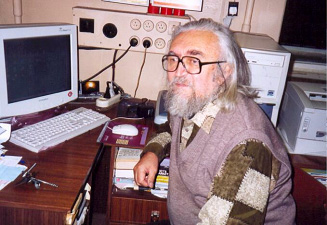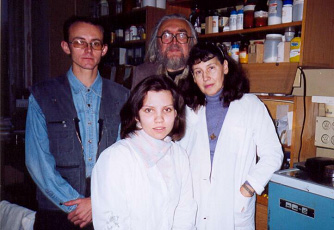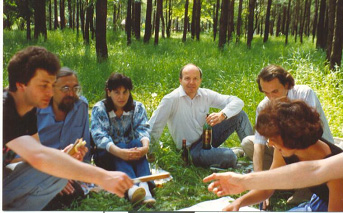| Group of Mitosis Genetics |
SOIDLA Tonu R.Leading scientist, Ph.D., D.Sc.phone: (812) 297-44-39
The head of the Group since 1991 Dr. Tonu Soidla is a specialist in molecular genetics. His research interests during last years have been centered on studies of apoptosis and of prion-associated proteins. Group has been supported by grants of RFFS and INTAS. |

|

|
Group members
1. Senior scientist, Ph.D. O.V. Nevzglyadova
|
|
Laboratory of Mitosis Genetics was founded by Dr. Vladimir Larionov in 1989. Laboratory was mostly involved in studying yeast CHL genes, (involded in determination
of chromosome stability) and constructing original series of YAC vectors for cloning large foreign DNA fragments in yeast.
|

|
|
After V. Larionov the laboratory (soon to be renamed a group) was headed by T. Soidla.
First direction of studies in the new group emerged together with original computer program allowing us to reveal so called stereospecific anomalies: DNA regions where there is a considerable difference in nucleotide composition between two sides of DNA double helix. We demonstrated that large sterospecific anomalies often coincide with regulatory zones (promoters and enhancers) and with some centromere-like structures. Our hypothesis was that stereospecific anomalies mark regions of giant DNA-protein complexes. These complexes involve low-affinity sites of DNA-protein interaction and their presence leads to high local concentration of regulatory proteins able to interact with nearby functional sites in enhancers and promoter regions. In details we analyzed DNA sequences of yeast 2-micron plasmid, complete sequence of Saccharomyces cerevisiae genome, sequence of 21st human chromosome and selected genome fragments of other organisms. Stereospecific anomalies were found near many genes with high expression level and near mobile genetic elements. Conspicuous were "trains" of different stereospecific anomalies. Many large stereospecific anomalies were situated atregions devoid of specific dinucleotides. We described stereospecific anomalies at helical repeat estimates characteristic for B-, A- and Z-DNA. Second line of studies is concerned with nuclear transmission in yeast heterokaryons. Heterokaryotic zygotes in yeast provide a unique possibility to study the survival
and transmission of two genetically diverse nuclei in one cell. We demonstrated that defects in cell fusion during mating can lead to programmed cell death during mitoc
division of heterokaryons in the yeast Saccharomyces cerevisiae. We performed partial pedigree analysis of nine kar1 · KAR1 crosses of two different types (four
alpha KAR1 a kar1 and five alpha kar1 a KAR1 crosses). Quantitative estimates of the frequencies of different mother/daughter (m/d) classes were obtained. The kar1
mutation affects nuclear congression and delays nuclear fusion. In each cross tested, the nucleus that entered the first bud tended to be the one contributed by the cell that
carried the wild-type allele of KAR1. If budding was delayed by nutrient limitation, the kar1 nucleus could be rescued, indicating that the primary effect of the kar1 mutation is
that it slows spindle action. Many m/d classes appear as a result of the degradation of one of the nuclei in the heterokaryon. Loss of nuclei in heterokaryons was
accompanied by an accumulation of reactive oxygen species (ROS), and by abnormalities in nuclear structure revealed by TUNEL (terminal transferase-mediated dUTP nick
end-labeling) analysis, DAPI staining and by histone-GFP fluorescence patterns which suggested an apoptosis-like process. Often only one nucleus was degraded, and ROS
accumulation was restricted to one half of the zygote. We therefore suggest that the data obtained can be explained by apoptosis-like death of a half-cell (cell body).
These facts led us to third line of studies concerned with yeast prions. A large group of prion-associated proteins was identified in yeast cells using a new approach, comparative analysis of pellet proteins of crude cell lysates in isogenic strains of Saccharomyces cerevisiae differing by their prion composition. Two dimensional (2D) electrophoresis followed by MALDI analysis of the pellet proteins of [PSI+] and [psi-] strains after prion elimination by GuHCl and prion transmission by cytoduction permitted identification of ca. 40 proteins whose aggregation state correlated with the change of prion(s) content. Approximately half of these proteins belonged to chaperones and to enzymes of glucose metabolism. Chaperones are known to be involved in prion metabolism and are expected to be present in prion containing aggregates, but glucose metabolism enzymes are not predicted to be present. Nevertheless, several recent data suggest that their presence is not incidental. We detected six proteins involved in oxidative stress response and eight in translation. Also notable is a protease. Most of the identified proteins seem to be prion-associated, but we cannot exclude the possibility that several proteins may propagate as prions. There are some proteins (e.g. Sod1p and Cus1p) that can be "clients" of a hypothetical prion generation pathway dealing with not NQ-rich proteins in yeast. Also we found ca. 35 proteins whose aggregation state depended on red pigment accumulation in yeast cells. Our model experiments demonstrate that red pigment binds insulin fibrils and blocks their interaction with Thioflavine T. This allows concluding that red pigment impedes mobilization of some prion-associated proteins to prion-containing aggregates and so makes them to appear as pigment depending ones. Major publications (1998-2009): T. R. Soidla, & N. I. Lukina (1998). Stereospecific anomalies in the structure of five sequenced yeast chromosomes. Tsitologiya, 40 (7), 661-676 [In Russian, English summary]. O. V. Nevzglyadova, S. G. Davydenko, T. I. Smirnova, & T. R. Soidla (1998). Cryptic heterokaryons in Saccharomyces cerevisiae strains. Part 1. Pseudo-pleiotropic suppression in strain YPH857. Genetika, 34 (12), 1597-1602 [In Russian, English summary]. English translation in: Russian Journal of Genetics, 34 (12), 1359-1364. O. V. Nevzglyadova, S. G. Davydenko, T. I. Smirnova, & T. R. Soidla (1998). Cryptic heterokaryons in Saccharomyces cerevisiae strains. Part 2. Model experiments. Genetika, 34 (12), 1603-1609 [In Russian, English summary]. English translation in: Russian Journal of Genetics, 34 (12), 1365-1370. T. R. Soidla, & N. I. Lukina (1999). Stereospecific anomalies in the structure of chromosomes IV, VII, VIII, X and XI in yeast. Tsitologiya, 41 (6), 521-536 [In Russian, English summary]. T. R. Soidla, & N. I. Lukina. (2000). Stereospecific anomalies in the structure of chromosomes V, XII, XIII, XIV, XV and XVI in yeast. Tsitologiya, 42 (8), 802-821 [In Russian, English summary]. O. V. Nevzglyadova, T. I. Smirnova, A. A. Gaivoronskii, & T. R. Soidla (2000). Cryptic heterokaryons in Saccharomyces cerevisiae strains: Conditions for appearance of a cryptic nucleus. Genetika, 36 (8), 1017-1024 [In Russian, English summary]. English translation in: Russian Journal of Genetics, 36 (8), 838-844. O. V. Nevzglyadova, A. A. Gaivoronskii, A. V. Artemov, T. I. Smirnova, T. R. Soidla (2001). Detection of concealed "illegitimate" nuclei in tetrad analysis of the diploid progeny of heterokaryons in Saccharomyces cerevisiae. Genetika, 37 (6), 754-761 [In Russian, English summary]. English translation in: Russian Journal of Genetics, 37 (6), 617-623. O. V. Nevzglyadova, A. A., Gaivoronskii, A. V. Artyomov, T. R. Soidla (2002). Factors affecting the frequency of concealed heterokaryosis in Saccharomyces cerevisiae. Genetika, 38 (3), 293-299 [In Russian, English summary]. English translation in: Russian Journal of Genetics, 38 (3), 223-229. N. I. Lukina, & T. R. Soidla (2002). Stereospecific anomalies in the human chromosome 21. Tsitologiya, 44 (6), 585-591 [In Russian, English summary]. O. V. Nevzglyadova, A. V.Artyomov, A. A.Gaivoronskii, T. R.Soidla (2002). Concealed nuclei in Saccharomyces strains. (Review). FEMS Yeast Research, 2 (4), 471-479. Verkhusha V. V., Shavlovsky M.M., Nevzglyadova O.V., Gaivoronsky A.A., Artemov A.V., Stepanenko O.V., Kuznetsova I.M., Turoverov K.K. (2003). Expression of recombinant GFP-actin fusion protein in the methylotropic yeast Pichia pastoris. FEMS Yeast Research, 3 (1), 105-111. N. I. Lukina, & T. R. Soidla (2004). Phylogenetic analysis of yeast genes flanked with large stereospecific anomalies in their promoter region. Tsitologiya, 46 (3), 277-282 [In Russian, English summary]. Nevzglyadova O. V., Artyomov A. V., Mikhailova E.V., & Soidla T. R. (2004). The impact of manipulations with cytoplasmatically inherited factors on nuclear transmission and degradation in yeast heterokaryons. Current Genetics, 45 (5), 273-282. Davydenko S. G., Juselius J. K., Munder T., Bogengruber E., Jantti J., & Keranen S. (2004) Screening for novel essential genes of Saccharomyces cerevisiae involved in protein secretion. Yeast, 21 (6), 463-471. Davydenko S. G., Feng D., Jantti J., & Keranen S. (2005) Characterization of GPI14/YJ013w mutation that induces the cell wall integrity signaling pathway and results in increased protein production in Saccharomyces cerevisiae. Yeast, 22 (12), 993-1009. Nevzglyadova O. V., Artyomov A. V., Mikhailova E.V., & Soidla T. R. (2005). Bud selection and apoptosis-like degradation of nuclei in yeast heterokaryons: a KAR1 effect. Mol. Gen. Genomics, 274 (4), 419-427. Nevzglyadova O. V., Artemov A. V., Zenin V. V., Verkhusha V. V., Shavlovsky M. M., Povarova O. I., Stepanenko O. V., Kuznetsova I. M., & Turoverov K. K. (2007) Expression of recombinant actin 5C from Drosophila in the methylotrophyc yeast Pichia pastoris. Cell and Tissue Biology, 1 (3), 248-258. Nevzglyadova O. V., Kuznetsova I. M. , Artemov A. V., Mikhailova E. V., Turoverov K. K., Soidla T. R. (2008) Comparative assay of amyloid and prion contents in yeast cells. Cell and Tissue Biology, 2 (1), 71-80. Nevzglyadova O.V., Artemov A.V., Mittenberg A.G., Solovyov K.V., Kostyleva E.I., Mikhailova E.V., Kuznetsova I.M., Turoverov K.K., Soidla T.R. (2009) Prion-associated proteins in yeast: comparative analysis of isogenic [PSI+] and [psi-] strains. Yeast, 26 (11), 611-631. Nevzglyadova O.V., Artemov A.V., Mittenberg A.G., Kostyleva E.I., Mikhailova E.V., Solovev K.V., Kuznetsova I.M., Turoverov K.K., Soidla T.R. (2010) Comparison of crude lysate pellets of isogenic strains of yeast with different prion composition: Identification of prion-associated proteins. Cell and Tissue Biology, 4 (1), 36-53. Nevzglyadova O.V., Artemov A.V., Mittenberg A.G., Mikhailova E.V., Kuznetsova I.M., Turoverov K.K., Soidla T.R. (2010) The effect of red pigment on amyloidization of yeast proteins. Cell and Tissue Biology (In press). Nevzglyadova O.V., Artemov A.V., Mittenberg A.G., Mikhailova E.V., Kuznetsova I.M., Turoverov K.K., Soidla T.R. (2010) Chapter 6. Yeast Protein Aggregates, Containing Chaperones and Glucose Metabolism Enzymes. In: Handbook of Molecular Chaperones: Roles, Structures and Mechanisms (P. Durante and L. Colucci, Eds), Nova Science Publishers, Hauppauge, NY, USA (In press). |